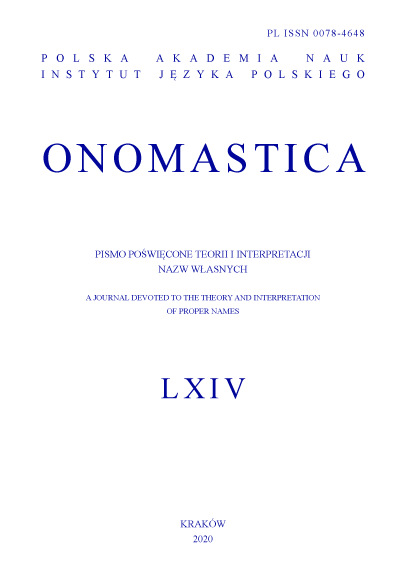Streszczenie
Artykuł sygnalizuje problem zakodowanego w nazwach własnych językowego obrazu świata i jego przekładu. Chińskie onimy i ich formy adresatywne przekazują odbiorcy informacje o wzajemnych relacjach między mówiącym a nazywanym, rysując tym samym szerszy obraz relacji społecznych w małych wspólnotach językowych i kulturowych. Przekład tych onimów na język obcy z zachowaniem ich funkcji społecznej jest wyzwaniem dla tłumacza. Jako egzemplifikację autorka wybrała przekład chińskiego zbioru opowiadań na język polskim za pośrednictwem języka niemieckiego, co temat komplikuje, wprowadzając dodatkową płaszczyznę koherencji. Nawiązując do teorii JOSu oraz nazw własnych w ogóle dokonano krytycznej analizy konkretnego tłumaczenia utworów pod kątem przekładu onimów i ich potencjału przekazania obrazu świata, z naciskiem na przekaz funkcji społecznej nazw własnych w języku docelowym. Uwzględniono także wpływ onimów i ich konsekwentnego potraktowania w przekładzie na spójność badanego tekstu.
Bibliografia
Ackermann, T. (2018). Grammatik der Namen im Wandel: Diachrone Morphosyntax der Personennamen im Deutschen. Berlin–München–Boston: De Gruyter.
Biel, Ł. (2007). Językowy obraz relacji interpersonalnych: różnice w wyrażaniu dystansu psychologicznego i społeczego w języku angielskim i polskim [A linguistic depiction of interpersonal relations: differences in expressing psychological and social distance in English and Polish.]. W: A. Szczęsny, K. Hejwowski (red.), Językowy obraz świata w oryginale i przekładzie: materiały z konferencji naukowej zorganizowanej przez Instytut Lingwistyki Stosowanej Uniwersytetu Warszawskiego w Warszawie w dniach 25–27 listopada 2005 (s. 513–522). Siedlce: Instytut Lingwistyki Stosowanej, Uniwersytet Warszawski.
Cataldi, A. (2009). Nieprzekładalność słownictwa a zawartość podtekstu kulturowego [The untranslatability of vocabulary and content with cultural overtones]. Rocznik Przekładoznawczy. Studia Nad Teorią, Praktyką i Dydaktyką Przekładu, 5, 69–81.
Czachur, W. (2011). Diskursive Weltbilder im Kontrast. Linguistische Konzeption und Methode der kontrastiven Diskursanalyse deutscher und polnischer Medien. Wrocław: Atut Oficyna Wydawnicza.
Dębski, A. (2006). Translatologia. Podstawowe problemy, stan i perspektywy badań, zainteresowania badaczy [Translatology. Basic problems, research status and perspectives, researchers’ interests]. Rocznik Przekładoznawczy. Studia nad Teorią, Praktyką i Dydaktyką Przekładu, 2, 11–39. https://doi.org/10.12775/RP.2006.001
Debus, F. (2002). Namen in den literarischen Werken: (Er-)Findung — Form — Funktion. Stuttgart: Franz Steiner Verlag.
Drosdowski, G., Eckey, W., & Dudenredaktion (Bibliographisches Institut). (1988). Duden Stilwörterbuch der deutschen Sprache: Die Verwendung der Wörter im Satz. Mannheim: Dudenverlag.
Dudenredaktion (b.d.). Duden online. https://www.duden.de
Galewska, K. (2019). Tłumaczenie chińskich nazw własnych w ujęciu kognitywnym [The translation of Chinese proper names: A cognitive approach]. Onomastica, 63, 263–278.
Gicala, A. (2018). Przekładanie obrazu świata. Językowy obraz świata w przekładzie artystycznym [Translating the image of the world. The linguistic image of the world in artistic trans lation]. Kraków: Universitas.
Hejwowski, K. (2004). Kognitywno-komunikacyjna teoria przekładu [A cognitive-communicative theory of translation]. Warszawa: Wydawnictwo Naukowe PWN.
Hengst, K. (2005). Wege der Poetonomastik. W: A. Brendler, S. Brendler (red.). Namenforschung morgen. Ideen, Perspektiven, Visionen (s. 81–86). Hamburg: Baar-Verlag.
Jakiel, R., Jarosz, J. (2013). Zum Gebrauch der Übersetzungstechniken bei der Wiedergabe der Eigennamen in der deutschen Translation des Romans von J. R. R. Tolkien „The Lord of the Rings”. Germanica Wratislaviensia, 137(3471), 95–112.
Kalverkämper, H. (1978). Textlinguistik der Eigennamen. Stuttgart: Klett-Cotta.
Katan, D. (1999). Translating Cultures. An Introduction for Translators, Interpreters and Mediators. W: J. Munday (red.). The Routledge Companion to Translation Studies (s. 74–92). London–New York: Routledge, Taylor & Francis Group.
Kautz, U. (2000). Handbuch Didaktik des Übersetzens und Dolmetschens. München: Iudicium Verlag.
Kosyl, C. (1983). Forma i funkcja nazw własnych. Lublin: Uniwersytet Marii Curie-Skłodowskiej.
Kromp, I. (2008). Eigennamen in der deutschen und polnischen Kinderliteratur unter textlinguistischem und translatorischem Aspekt. Frankfurt am Main: Peter Lang.
Labocha, J. (2000). Tekst (Text). W: U. Dąmbska-Prokop (red.). Mała encyklopedia przekładoznawstwa [A small encyclopedia of translation studies] (s. 230–233). Częstochowa: Educator.
Lewicki, R. (2000). Obcość w odbiorze przekładu [Strangeness in the reception of translation]. Lublin: Uniwersytet Marii Curie-Skłodowskiej.
Niebrzegowska-Bartmińsk a, S. (2017). Jakie dane są relewantne etnolingwistycznie? Etnolingwistyka, 29, 11–28.
Pieciul-Karmińska, E. (2007). Językowy obraz Boga i świata. O przekładzie teologii niemieckiej na język polski [The linguistic image of God and the world: On the translation of German theological writings into Polish]. Poznań: Wydawnictwo Poznańskie.
Sapir, E. (1978). Status lingwistyki jako nauki [The status of linguistics as a science]. W: E. Sapir, Kultura, język, osobowość. Wybrane eseje [Culture, language and personality. Selected essays] (s. 85–95). Warszawa: PIW.
SJP — PWN (b.d.). Stary. W: Słownik języka polskiego PWN. https://sjp.pwn.pl/sjp/stary-I;2523945.html
SJPDor — Doroszewski, W. (red.) (1997). Słownik języka polskiego [cyfrowy reprint wydania książkowego, opublikowanego w Warszawie w 1969 r.]. Warszawa: PWN. https://sjp.pwn.pl/doroszewski
Thurmair, M. (2002). Eigennamen als kulturspezifische Symbole oder: Was Sie schon immer über Eigennamen wissen wollten. Anglogermanica Online, 2002–1, 84–102. http://epub.uni-regensburg.de/25138/
Tokarski, R. (1980). Brat, brach, braciszek, braciec. W: J. Bartmiński (red.), Słownik ludowych stereotypów językowych. Zeszyt próbny [A dictionary of folk linguistic stereotypes. A trial issue] (s. 69–73).Wrocław: Wydawnictwo Uniwersytetu Wrocławskiego.
Wahrig, G. (1986/1991). Deutsches Wörterbuch mit einem „Lexikon der deutschen Sprachlehre”. Gütersloh–München: Bertelsmann Lexikon Verlag.
Wilkoń, A. (1970). Nazewnictwo w utworach Stefana Żeromskiego [Names in the works of Stefan Żeromski]. Wrocław: Zakład Narodowy im. Ossolińskich.
Yin-Poole, W. (2011, 23 lutego). The brains behind Pokemon Black and White. GameFreak reveals all in a rare interview. Eurogamer. https://www.eurogamer.net/articles/2011-02-22-the-brains-behind-pokemon-black-and-white-interview.
Zawadzki, J. (2015). Dawna literatura chińska. Antologia i omówienie. Tom I (od początków do X w. n.e.) [Ancient Chinese literature. An anthology and discussion. Volume I (from its origins to the 10th century AD).]. CreateSpace Independent Publishing Platform.
Zhongguo (2014, 21 maja). Nazwiska i imiona w Chinach [Surnames and given names in China]. Centrum Studiów Polska-Azja (CSPA). http://www.polska-azja.pl/nazwiska-i-imiona-w-chinach/.
Zinken, J. (2016). Jakich danych potrzebuje etnolingwistyka porównawcza? Etnolingwistyka, 28, 334–336.


